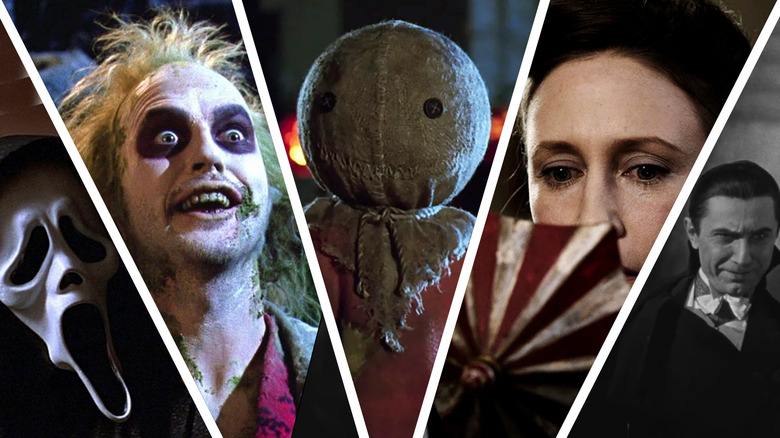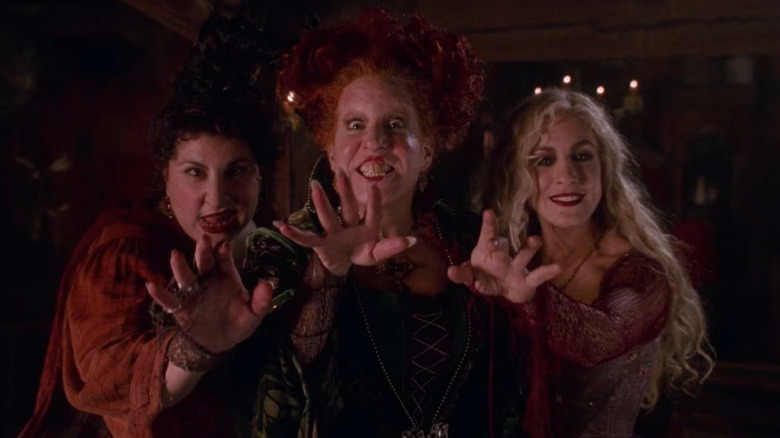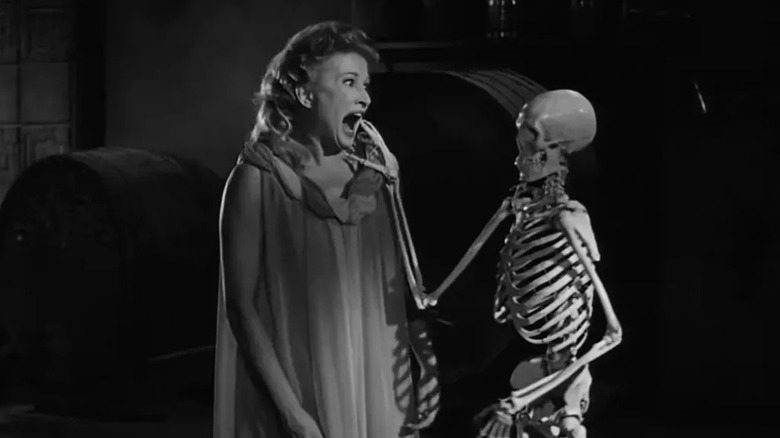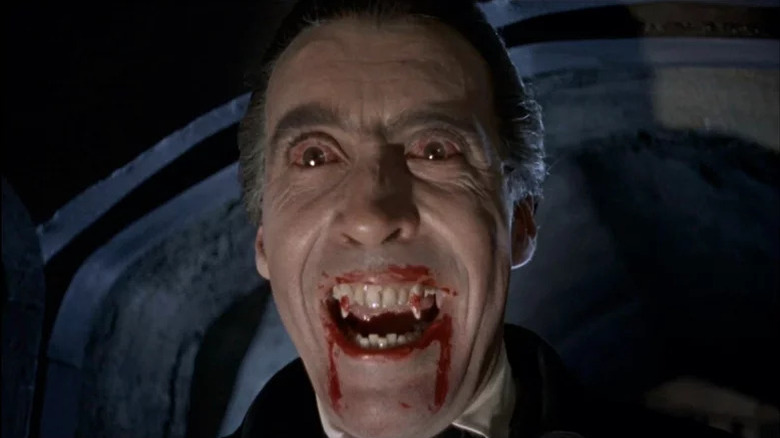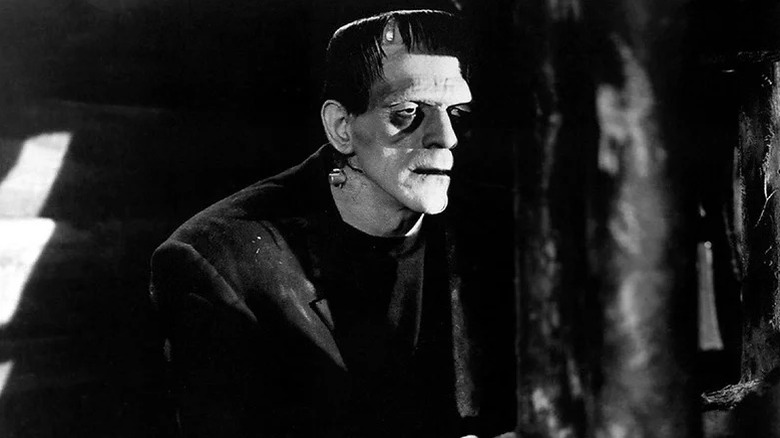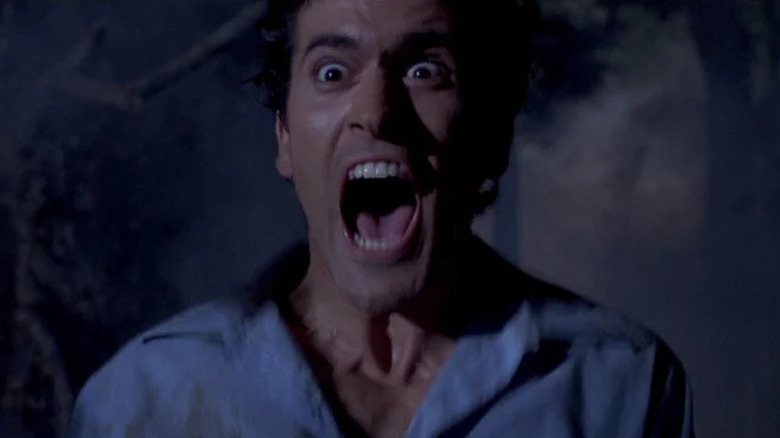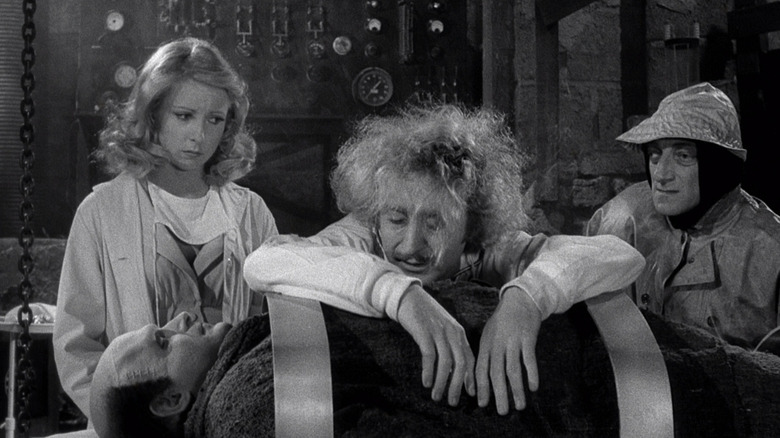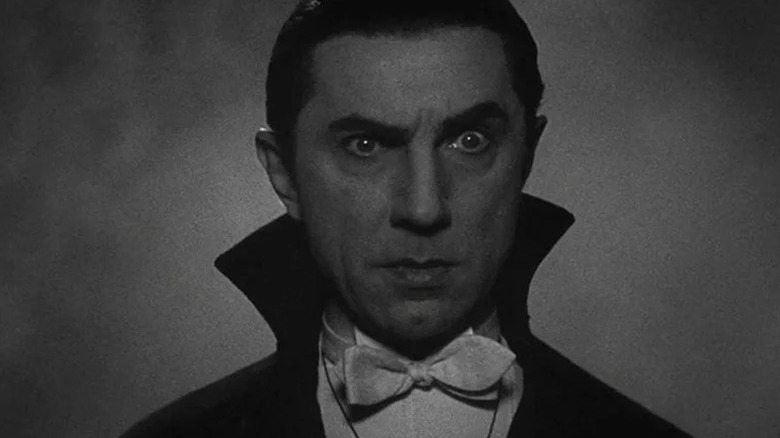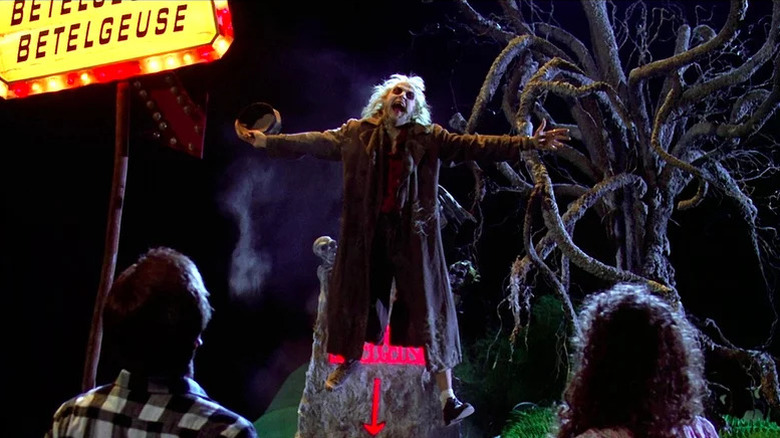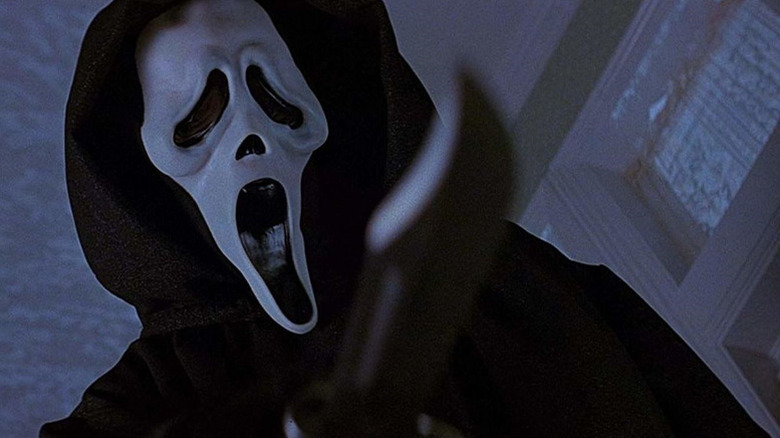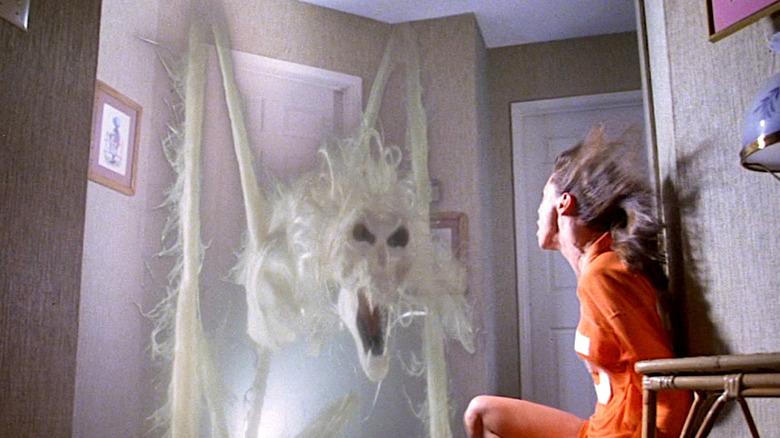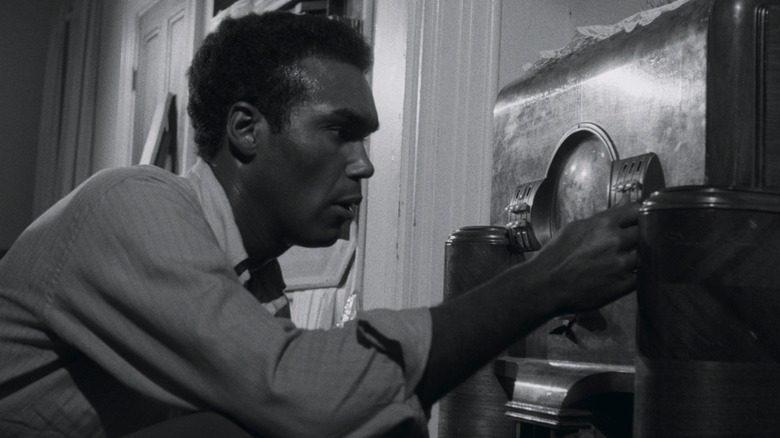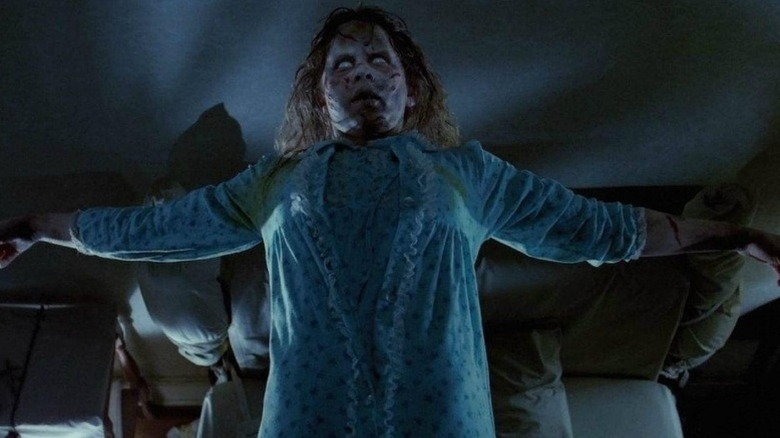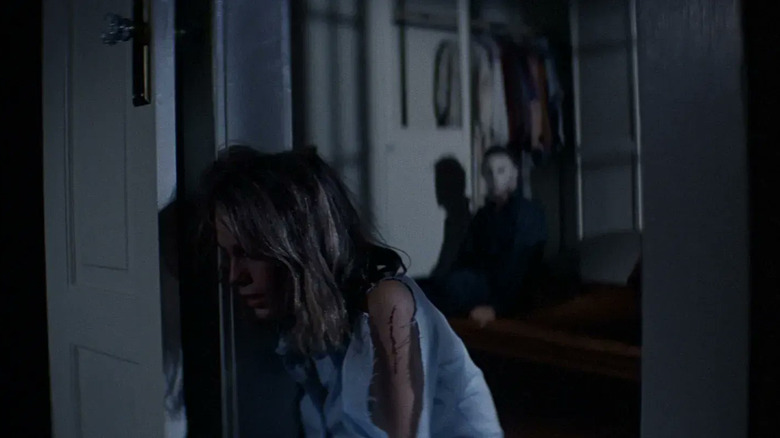The Best Movies To Watch During Halloween, Ranked
Halloween is one of the most atmospheric holidays of the year, not only signaling the pinnacle of the autumnal season but embracing supernatural and sinister cultural aesthetics. The latter sensibilities are reinforced by an abundance of scary movies that highlight the ghoulish appeal and tones that come with the Halloween season. There is a certain mood linked to Halloween, from the foliage changing colors to a growing chill in the air, and a number of horror movies reflect that environment. The more those movies allude to the Halloween season, the better they are for an October binge around the holiday.
Not only do the following movies stand among the best horror movies ever made, but they often take advantage of the seasonal aspects associated with Halloween. This means, as much as we love science fiction horror, those movies aren't present here. Similarly, horror movies with a clear wintry or summertime setting have also been omitted from this list. With those qualities in mind, here are the best movies to watch during Halloween, ranked.
Hocus Pocus
Starting off with a family-friendly movie on this list is 1993's "Hocus Pocus," starring Bette Midler, Sarah Jessica Parker, and Kathy Najimy as the witchy Sanderson sisters. After being hanged during the Salem Witch Trials, the evil siblings are resurrected three centuries later from an enchantment that they cast in their final moments. The witches must consume the soul of a child in order to remain alive past Halloween, targeting Max Dennison (Omri Katz) and his young sister Dani (Thora Birch). The kids are aided by Thackeray Binx (Jason Marsden), a 17th century boy cursed to transform into a talking cat by the witches.
Admittedly, a lot of the appeal for millennials regarding "Hocus Pocus" is the sheer nostalgia from growing up with the movie. That said, the goofy performances from Midler, Parker, and Najimy still hold up well, particularly during the musical sequence set to "I Put a Spell on You." That comedic dynamic helped turn the movie from a box office flop to a Halloween cult classic that continues to endure. More of a fantasy comedy than anything overtly scary, by design, "Hocus Pocus" is a great gateway movie into the horror genre.
House on Haunted Hill (1959)
The 1999 "House on Haunted Hill" remake certainly has earned its own fair share of fans, but the 1959 original movie is still leagues better. The film stars Vincent Price as millionaire Frederick Loren ,who invites five strangers to spend the night at a notorious haunted house in exchange for a large cash payout. The gathering is ostensibly a party for Frederick's estranged wife Annabelle (Carol Ohmart), though it's clear that the married couple completely despise each other. As the night progresses, the guests experience the paranormal, learn about the mansion's dark history, and endure betrayal and murder.
The original "House on Haunted Hill" was directed and produced by William Castle, a filmmaker who approached his projects with the aplomb of a carnival showman. That's evident here, with the movie containing jump scares and fourth wall-breaking moments, years before either trope was commonplace. Grounding it all is Price, who underplays his role as the party's host without compromising his usual menacing presence. A very different viewing experience than its 1999 remake, the 1959 "House on Haunted Hill" has plenty of fun with its premise.
Dracula (1958)
The British film studio Hammer left its own impact on the Dracula mythos with its 1958 movie "Dracula," released as "Horror of Dracula" in 1958. In this version of Bram Stoker's classic tale, Jonathan Harker (John Van Eyssen) is a vampire hunter out to destroy the vampiric count, played by Christopher Lee. After Harker fails, Dracula turns his bloodthirsty attention to Harker's loved ones, including Arthur Holmwood (Michael Gough) and his wife Mina (Melissa Stribling). With Mina under threat of becoming Dracula's vampire bride, Harker's mentor Van Helsing (Peter Cushing) sets out to destroy the undead villain.
While Bela Lugosi immortalized Dracula on the silver screen, Christopher Lee made the character his own right from his first appearance as the count. Lee's Dracula has a real bite in contrast to Lugosi's, with the 1958 movie leaning more into graphic bloodletting than its black-and-white predecessors ever did. Lee is perfectly matched by Cushing's Van Helsing who, despite the number of Dracula movies Lee starred in, only served as Dracula's adversary a handful of times. Starting a line of Hammer-produced Dracula movies that forever associated Lee with the character and became increasingly atmospheric and violent, the 1958 "Dracula" is still his best work as the vampire.
Frankenstein (1931)
1931 was a seminal year for horror cinema, with Universal Pictures releasing both "Dracula" and "Frankenstein." The latter was based on the 1927 stage play adaptation of Mary Shelley's 1818 novel, with Henry Frankenstein (Colin Clive) obsessed with resurrecting the dead through science. Working feverishly in his remote castle with body parts stolen from the recently deceased, Frankenstein succeeds in raising an imposing monster (Boris Karloff) from previously dead tissue. However, the monster quickly goes out of control, murdering Frankenstein's assistant and terrorizing the surrounding countryside.
There's a reason why Karloff's performance as Frankenstein's monster is still recognized as the most common archetype for the creature: He completely dominates every scene he's in, unpredictably terrifying and yet playing a monster we actually feel sorry for by instilling a tragic sympathy. Similarly, Clive brings a wild-eyed intensity to his performance as Henry Frankenstein, obsessive and utterly driven, no matter the cost. The 1931 "Frankenstein" is still the bar against which all subsequent movies featuring the monster have been judged and it captures the Halloween mood perfectly.
Trick 'r Treat
Though it features an impressive ensemble cast and well-earned reputation in the horror community, 2007's "Trick 'r Treat" is technically a direct-to-video movie. Don't let this lack of wide theatrical release (at least until recently) dampen its standing, however, because the movie is one of the best horror movies set on Halloween since, well, "Halloween." The movie features a set of interconnected vignettes in the fictional Midwestern town of Warren Valley on Halloween night. As the holiday progresses, everything from serial killers and werewolves to the movie's de facto mascot Sam deliver the autumnal chills.
A cult movie that has enjoyed a growing following, "Trick 'r Treat" captures so much of Halloween's appeal. The vignette-style storytelling allows the film to explore different aspects of the horror genre while keeping it connected to its evocative small-town setting. The scares come from a visceral place, but often with a self-aware wink to the audience letting them in on the fun. While it took a strange journey to become a Halloween classic, "Trick 'r Treat" has garnered the wider recognition it deserves.
Evil Dead II
Really, any of filmmaker Sam Raimi's "Evil Dead" movies could earn a spot on this list, but we'll always have a soft spot for 1987's "Evil Dead II." Co-written by the late Scott Spiegel, the sequel starts out as a retread of its 1981 predecessor, with Ash Williams (Bruce Campbell) traveling to a remote cabin in the woods. After accidentally unleashing malevolent spirits through an unholy text known as the Necronomicon, Ash barely emerges as the sole survivor of his first night in the cabin. Ash recovers just in time for a new hapless group to arrive at the cabin for a fresh night of terror and monstrous reanimation.
"Evil Dead II" is one of those sequels that genuinely goes bigger and better than its predecessor, restaging its scares on a grander scale. The movie also has a more pronounced sense of humor than the original "Evil Dead," often veering into outright slapstick at Ash's expense. This balance of horror and comedy is delivered wonderfully by Campbell, simultaneously playing Ash as a clueless goofball and wise-cracking hero. Arguably the best "Evil Dead" movie to date, "Evil Dead II" is that rare sequel that truly outdoes its predecessor.
Young Frankenstein
"Evil Dead" is far from the first horror comedy around, with legendary funnyman filmmaker Mel Brooks memorably stepping into the genre with 1974's "Young Frankenstein." The titular protagonist is Frederick Frankenstein (Gene Wilder), who inherits his family's Transylvanian castle where he discovers his late grandfather's secret lab and research. This inspires him to replicate his grandfather's infamous experiment, creating a similarly hulking and uncontrollable monster (Peter Boyle). Joining Frankenstein are his assistants Inga (Teri Garr) and Igor (Marty Feldman), who repeatedly insists that his name isn't pronounced as it's spelled.
"Young Frankenstein" is both a love letter and send-up of Universal's line of "Frankenstein" movies in the '30s and '40s, right down to the black-and-white cinematography. Both Brooks and Wilder were avowed fans of Universal's movies and that passion meshes well with their comedic sensibilities. This makes the film feel like a spiritual successor to the classics that inspired it while both showcasing Brooks and Wilder at the top of their game. More than just one of the best horror comedies around, "Young Frankenstein" proudly stands as the best Mel Brooks movie overall.
The Conjuring
Though self-professed demonologists Ed and Lorraine Warren may have been divisive figures in real-life, the "Conjuring" franchise built around them is one of the biggest in the horror genre. The original 2013 movie introduces Ed (Patrick Wilson) and Lorraine (Vera Farmiga) as they investigate an evil spirit haunting a farmhouse in Rhode Island. As the Warrens learn the dark history behind the property, the malevolent entity possesses one of the women living at the farmhouse, intent to use her in killing again. The Warrens race against time to prevent the entity from claiming more victims as they work to exorcise the spirit back to Hell.
As good as the subsequent sequels and spin-offs are, the original "Conjuring" is still the best in its shared cinematic universe. A lot of that retained appeal comes from the fact that the movie is a well-constructed haunted house story, eschewing any major genre frills. What that means is that the movie's scares and overall effectiveness comes from its foreboding atmosphere and solid cast. "The Conjuring" launched a multibillion franchise and that came from an inaugural movie something distinctly well-crafted and fresh in the horror space.
Dracula (1931)
What Boris Karloff did for Frankenstein, Bela Lugosi did for Dracula, with both actors introducing audiences to their iconic horror characters in 1931. Lugosi had starred in a popular stage adaptation of Bram Stoker's novel and public pressure convinced Universal to cast him in the film version. The movie recreates the broad elements of Stoker's story, with Dracula traveling to London where he becomes determined to turn Mina Seward (Helen Chandler) into his latest vampire bride. After his undead nature is exposed by Van Helsing (Edward Van Sloan), Dracula flees to his Transylvanian castle with Mina, with Van Helsing and his associates in pursuit.
From its beautifully decorated spooky castle to the movie's alluring use of light and shadow, the 1931 "Dracula" set the template for vampire movies moving forward. For Lugosi, the key to successful horror acting was playing it naturally and he brings that quality to his most famous role. Of the horror doubleheader Universal provided audiences in 1931, "Dracula" was the more chillingly atmospheric of the two and powered by a standout performance from Lugosi. The gold standard of vampire movies nearly a century since its release, "Dracula" is as entertaining as it is foundational.
Beetlejuice
Before they worked together on the 1989 "Batman," filmmaker Tim Burton and actor Michael Keaton collaborated on 1988's "Beetlejuice." Keaton plays the titular wise-cracking ghoul who is summoned by the recently deceased Adam (Alec Baldwin) and Barbara Maitland (Geena Davis) to scare the living yuppies who moved into their home. However, Betelgeuse proves to be more trouble than he's worth, developing an unhealthy attachment to new resident Lydia Deetz (Winona Ryder). The Maitlands try to stop Betelgeuse from inflicting any more harm, including bringing Lydia with him back to the afterlife.
Like many of Burton's projects, "Beetlejuice" proudly lets its freak flag fly, embracing what it means to be different and lovingly macabre. Michael Keaton delivers what is arguably his most memorable role, something he settles back into seamlessly in the movie's 2024 sequel. What makes Keaton's impact on the movie all the more impressive is that his performance amounts to less than 20 minutes of screen time. Though Burton had success before, "Beetlejuice" gave him the box office hit that defined his career and continues to deliver horror-tinged gags decades later.
Scream (1996)
Major studio horror movies were in a slump in the '90s until venerated genre filmmaker Wes Craven completely reinvigorated it with 1996's "Scream." A revival of the slasher movies that dominated the genre in the '80s, the movie has a masked serial killer terrorizing the small town of Woodsboro. High schooler Sidney Prescott (Neve Campbell) suspects her boyfriend Billy Loomis (Skeet Ulrich) is responsible, but the killings continue without him. Eventually, Sidney finds the killer has a very special interest in her, culminating in a truly stellar ending showdown.
Bringing a self-awareness to the genre, "Scream" reevaluates and revives slashers by embracing and subverting its tropes in a very meta fashion. This postmodern approach doesn't distract from the fact that the movie is still quite chilling and viciously charming in its own right. The movie's iconic cold-blooded opening is the franchise at its most terrifying, with Craven masterfully dialing up the suspense and violence. In evoking and celebrating the legacy of slasher movies, "Scream" catapulted itself to become one of the defining movies of the genre.
Poltergeist (1982)
Producer and co-writer Steven Spielberg teamed up with director Tobe Hooper for the 1982 haunted house movie "Poltergeist." Inspired by a chilling true story, the movie follows the Freeling family shortly after they move into a newly constructed suburban community in California. After the Freelings' young daughter Carol Anne (Heather O'Rourke) communicates with a strange entity in the home's television set, paranormal activity picks up around the house. When Carol Anne is abducted by the spirits into an otherworldly plane, the Freelings look for help to rescue their daughter.
With its familial themes and production values, "Poltergeist" feels more like a Spielberg project than a Hooper one, though the "Texas Chain Saw Massacre" filmmaker's presence shines through. Though frightening unease permeates throughout the movie, most of the scares, with one face-ripping exception, are relatively accessible for non-horror fans. What makes that terror work is that the Freeling household feels like a typical '80s suburban home that just happens to be the site for the menacingly supernatural. An exploration of the dark side of Spielberg's suburbia, "Poltergeist" is an '80s horror gem that stands among his best work from the decade.
Night of the Living Dead (1968)
Zombie movies had existed before filmmaker George A. Romero made 1968's "Night of the Living Dead," but they were never the same afterward. Set in rural Pennsylvania, the movie has the dead suddenly rise to feast on the flesh of the living, ambushing unaware siblings Barbra (Judith O'Dea) and Johnny (Russell Streiner). Barely escaping with her life, Barbra seeks refuge in a nearby farmhouse, where she is joined by other survivors, including Ben (Duane Jones). As night falls, the farmhouse is besieged by the zombies while internal tensions rise among the group.
Compared to so many other horror movies of its time, "Night of the Living Dead" is just uncompromisingly bleak, something underscored by the movie's ending (which was almost completely different). Given its relatively short runtime, that sense of escalation and dread steadily grows, making the raised stakes feel all the more dire. The black-and-white cinematography actually helps emphasize those narrative sensibilities, making the movie feel starker and grimmer as the darkness grows. A genre-defining masterpiece, "Night of the Living Dead" starts out like any other cheap B-movie before it progresses into a nihilistic last stand.
The Exorcist
William Peter Blatty's 1971 novel "The Exorcist" received an iconic cinematic adaptation in 1973 directed by William Friedkin. With a screenplay written by Blatty himself, the movie has adolescent girl Regan MacNeil (Linda Blair) possessed by a demonic spirit. After medical solutions are exhausted, Regan's mother Chris (Ellen Burstyn) turns to disillusioned Catholic priest Father Damien Karras (Jason Miller) for help. Realizing Regan's possession is real, Karras summons veteran exorcist Father Lankester Merrin (Max von Sydow) to help him save the girl.
While its lackluster sequels may have diminished its legacy somewhat, "The Exorcist" is one of the greatest horror movies ever made. The film steadily escalates Regan's disturbing behavior after she's possessed to the point where she's practically unrecognizable due to the demonic influence. This parallels the emotionally weary performance from Miller, whose crisis of faith is challenged by his confrontation with pure evil. Simply put, modern horror cinema wouldn't exist without "The Exorcist" or Friedkin's creative vision for the movie.
Halloween (1978)
What better movie to watch on Halloween than the classic 1978 slasher that's named after the actual holiday? Fortunately, John Carpenter and Debra Hill's movie lives up to the seasonal association, introducing audiences to iconic masked killer Michael Myers (Nick Castle). Over 20 years after murdering his sister as a child, Myers escapes from the sanitarium where he had been incarcerated and returns to his hometown of Haddonfield, Illinois. After an unwitting Laurie Strode (Jamie Lee Curtis) visits his childhood home, Myers becomes fixated on murderously stalking her and her friends on Halloween night.
A violent coming-of-age movie, "Halloween" exercises a surprising amount of restraint for much of the film before cutting loose when the sun goes down. Myers' presence is felt, quietly shadowing Laurie and her friends, biding his time until his twisted trick-or-treat scare-fest unfolds. What so many slashers forget, including the "Halloween" sequels, is that deliberate pacing paying off into a virtuoso final act. A must-watch every October, Carpenter's "Halloween" delivers on its promise that everyone is entitled to at least one good scare.
